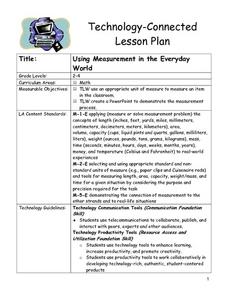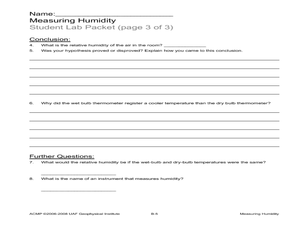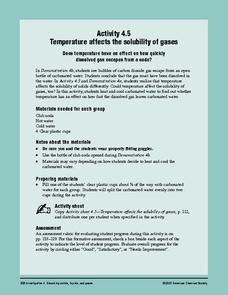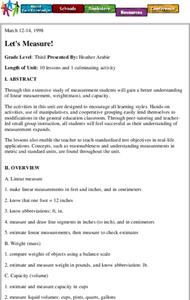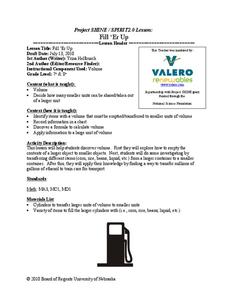Curated OER
Quarts and Gallons
In this worksheet about liquid measurement, students compare quarts and gallons. Students learn that four quarts equals one gallon. Students then look at eight different problems where there determine if the quarts shown represent a...
Santa Monica College
The Density of Liquids and Solids
There are underwater rivers that flow on the ocean floor thanks to a difference in density. Scholars learn about the density in both liquids and solids in the second lesson of an 11-part series. They then determine the density of water,...
Curated OER
Measuring Mixed Numbers
Mixed numbers can be added conceptually, algorithmically, and physically. Have the class visualize mixed numbers by adding fraction bars together. They then discover the algorithmic process that simplifies adding mixed numbers. Finally,...
Curated OER
Heterogeneous Equilibrium: Measurement of a Partition Coefficient
In this chemistry worksheet, students examine a concept in science and then use the knowledge in application by conducting an experiment.
Curated OER
Using Measurement in the Everyday World
Learners use an appropriate unit of measure to measure an item in the classroom. They create a PowerPoint to demonstrate the measurement process. Pupils are divided into pairs. Students use a concept map to discuss the terms for...
Curated OER
Measuring Humidity
Students measure humidity in the classroom. In this weather lesson, students use a psychrometer to measure the humidity in the classroom. Students complete a lab packet.
Curated OER
Metric Measurements of Capacity
In this metric measurements of capacity worksheet, 4th graders subtract two given metric liquid measures, then use the answers to answer three more questions.
American Chemical Society
Temperature Affects the Solubility of Gases
Dare your class to drive dissolved carbon dioxide out of carbonated liquid at different temperatures to discover if there is a difference in rate. To make this experiment more sound, have explorers use equally measured amounts of soda...
Curated OER
A Comparison of Polymeric Liquids with Newtonian Liquids
Students concretely illustrate and define a macromolecule, observe the unique behavior of polymers and relate to their knowledge of molecules, and use the scientific process to determine the difference between Newtonian and non-Newtonian...
Curated OER
Compared to What? Comparing the Density of Different Liquids
Students work in groups to compare the density of different liquids. In this density lesson, students use cooking oil, liquid detergent and water to measure density. Students record their results and check the accuracy of...
Creative Chemistry
How to Use the Burette
In this burette-use worksheet, students are given directions for titration using a burette. They practice reaching the end point of titrations and calculate the mean volume of three trials.
Curated OER
Measuring With Fluids
Students investigate the concept of measurement for capacity and they use real containers to be filled of different sizes. Students use the scoops as the number of units for counting the capacity volume. Then they order the containers by...
Curated OER
Measurement (Standard Measurement)
In this math learning exercise, students solve 7 problems in which standard measurements of ounces, cups, quarts and gallons are converted to larger or smaller units. There are also 2 word problems on the page which has no instruction or...
Curated OER
Units of Measurement Worksheet
In this units of measurement learning exercise, students answer 23 questions pertaining to the measurement of liquid, weight, time and money. Students can check their answers by clicking on the Check box. Note: these are all using...
Pingry School
The Gelation of Guar Gum with Borax
Some of kids' favorite toys are the products of science experiments. Scholars follow precise measurements to mix and create their own slime and Play-Doh. They observe the changing textures and the chemical reactions throughout the...
Curated OER
Specific Gravity-The Relative Density of Liquids
Students explore a hydrometer. In this gravity lesson students construct a hydrometer and create a liquid density column.
Curated OER
Density of Liquids
Students explore the density of liquids. In this scientific inquiry lesson plan, students discover the density of water, corn syrup, and cooking oil through an experiment. In addition, students will draw and label pictures of the...
Curated OER
Liquids in Bottles
Students investigate different liquids to develop their concept of a liquid. They work at a center to tip, swirl, shake, roll, and otherwise investigate seven liquids in small, clear plastic bottles: plain water, corn syrup, liquid...
Curated OER
Let's Measure
Third graders practice measuring different objects. They discover the concepts of ratio and proportion and practice converting numbers into the correct unit. They read stories as well to help them with the concepts.
Curated OER
Density of Solids and Liquids
Students calculate the density of regular and irregular solids and liquids. They relate the term dense to science as well as its literal meaning that society uses it as everyday. A worksheet is completed on density.
Curated OER
Metric Units of Capacity - Problem Solving 12.8
In this units of capacity worksheet, students read the word problems and solve the problems finding the metric units of capacity for each. In the 'use data' problem, students use the recipe to help them solve the problem.
Curated OER
Fill 'Er Up
Students identify how many smaller units can be found in a later unit. In this geometry lesson, students calculate the volume and the transfer amount to a smaller unit. They solve real life problems using the formula for volume.
Curated OER
Metric Units of Capacity - Homework 12.8
Upper graders convert liters and milliliters, choose the better estimates of capacity for objects, and choose the better unit to measure capacity. They solve eleven problems.
Curated OER
A Chemist in My Class?
First graders in kindergarten science class discuss matter. They make predictions and then identify mystery items in brown paper bags as either solid, liquid, or gas by using their senses. They discuss that a chemist is a scientist that...






